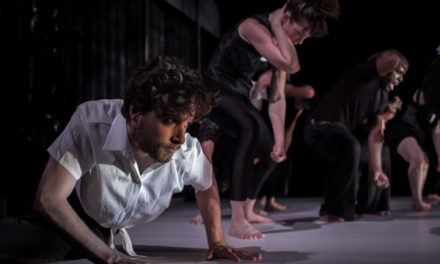
Lawrence Hilton-Jacobs (left) stars in “Airplanes vs. Volcano,” a B-list action movie produced by film knock-off company The Asylum. The film is available deep in the vaults of Netflix. / Courtesy of The Asylum
Have you ever wondered what you would do if a volcano started coming after you? Not just erupt. Apparently, the volcano has an unquenchable bloodlust that you cannot outrun. One minute you’re brushing your teeth, the next minute you’re consumed by heaps of lava that you didn’t see creeping behind you in the bathroom mirror. Well, I know I’ve worried day and night about volcanoes chasing me, until “Airplane vs. Volcano” addressed all my lava-related anxiety.
This 2014 B-list action flick follows the story of a commercial aircraft that must fly through a ring of newly formed volcanoes near Ka’ula Island near Hawaii. The volcanoes relentlessly spurt lava at anyone who dares cross their path, as if it is a personal offense. The chaos of the volcanic eruptions turns the aircraft into a pressure cooker of desperation. Meanwhile, U.S. military officials grapple with the decision of saving the people in the aircraft or evacuating the people who live near the volcano (because the military is apparently too small to do both of those things).
I should give full disclosure: this film was produced by The Asylum.
For those unfamiliar, The Asylum is a film studio famous for their “mockbusters” – direct to video knockoffs of popular movies, such as “Transmorphers: Fall of Man” and “Atlantic Rim.” The magnum opus of The Asylum’s filmography is the incomparable 2013 TV movie “Sharknado,” which gathered serious attention because it’s a movie about sharks in a tornado – what more could you want? So anyone familiar with The Asylum should ask this: does (cheesy) lightning strike twice?
The cast of characters is a laundry list of every action movie trope dummy you’ve ever seen. Dean Cain (whom you may remember as Superman from “Lois & Clark: The New Adventures of Superman”) stars as Rick Pierce, an amateur pilot who takes over the aircraft after the original pilot dies at the hands of the bloodthirsty volcano and its unusually precise onslaught. His commandeering of the flight is met with severe skepticism, particularly from passenger Carlos Crieger (David Vega), who attempts mutiny against Rick. Carlos is supposed to be a “foreign” character, but I am unsure what country his stereotypical performance is supposed to mock, so I’ll just assume that it’s offensive to everyone, Antarcticans included.
Lucky for Rick, he has ample support from flight attendant Lisa Whitmore (Robin Givens), volcanologist Landon Todd (Matt Mercer) and air marshal Jim Kirkland (Lawrence Hilton-Jacobs, who older people and TV nerds may remember as Freddie “Boom Boom” Washington from “Welcome Back, Kotter”).
None of the performances were spectacularly bad (admittedly, something I crave in any Asylum movie).
In fact, Hilton-Jacobs surprised me with a pretty good performance. He gives his role the authority that it does not even deserve. The Asylum should have cast him as the lead in “Snakes on a Train.”
The cinematography is the standard made-for-TV style: nothing stunning, but it works well enough to where you can’t complain. However, I have to say that I admire the bold use of lens flare whenever they cut to a scene with military personnel involved. I like to think the lens flare is The Asylum’s equivalent to a salute.
The dialogue scrambles together all the action movie dialogue you’ve ever heard with a few little nuggets of brilliance shining through, such as when Rick asks the question that plagues mankind to this day: “If I were a plane, what could I get rid of?”
The technical flaws in this movie are more obvious than a gigantic ash cloud rushing towards a city. Of course, the volcanologist aboard the flight gives Rick the grand advice of “don’t fly too close” to the volcano. Are you sure about that? Isn’t the first rule of volcanic eruptions to get up close and personal with the molten rock and fire? The passengers aboard this flight must also be acrobats, as they attempt feats such as fixing the engine and tossing luggage out of an open cargo hold during flight. The movie suggests that the best way to stop the eruption is by shooting the volcano.
You know, like in “Jaws.” Perhaps the biggest issue for me is the fact that they were flying for about an hour around these volcanoes. Ka’ula is only about a quarter of a square mile in size.
I’m no Amelia Earhart, but a quarter of a mile flight should not take an hour. If it does, you should receive a free drink coupon in the mail afterwards.
Perhaps the most fascinating aspect of the film is its poster, which confidently claims that “Airplane vs. Volcano” is “BASED ON THE TRUE STORY.” Which “true story” are they referring to? If something even slightly resembling the events of this film actually took place, people would have heard about it. It would be in history books as “The Great Airplane-Volcano War.” Dean Cain would be on a postage stamp.
The world as we know it would have changed.
Even with the many factors working against it – and there are many – “Airplane vs. Volcano” still manages to be an enjoyable B-movie.
Sure, it doesn’t make any sense when you think about it, but the movie has a way of tapping into your emotions and sucking you in, no matter how stupid the event on screen may seem. It’s nonstop action from start to finish – never a dull moment to sit and reflect on the fact that the volcanologists don’t know anything about volcanoes, and the pilot knows nothing about planes.
Highly recommended for people who want pure excitement to take the wheel. Or in this case, the aircraft yoke.
– By Erin Penney, Staff Writer
The Emory Wheel was founded in 1919 and is currently the only independent, student-run newspaper of Emory University. The Wheel publishes weekly on Wednesdays during the academic year, except during University holidays and scheduled publication intermissions.
The Wheel is financially and editorially independent from the University. All of its content is generated by the Wheel’s more than 100 student staff members and contributing writers, and its printing costs are covered by profits from self-generated advertising sales.







Awesome Critique!